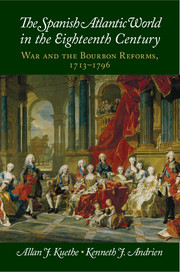Book contents
- Frontmatter
- Contents
- Introduction: War and Reform in Spain and Its Atlantic Empire
- I Alberoni, Patiño, and the Beginnings of Atlantic Reform, 1713–1736
- II The Second Wave of Reform, 1736–1763
- 4 War and Reform, 1736–1749
- 5 Clerical Reform and the Secularization of the Doctrinas de Indios
- 6 The Downfall of Ensenada and the Pause, 1750–1763
- III Pinnacle of the Bourbon Reforms, 1763–1796
- Timeline for the Spanish Atlantic World in the Eighteenth Century
- Bibliography
- Index
- Plate section
- References
6 - The Downfall of Ensenada and the Pause, 1750–1763
Published online by Cambridge University Press: 05 June 2014
- Frontmatter
- Contents
- Introduction: War and Reform in Spain and Its Atlantic Empire
- I Alberoni, Patiño, and the Beginnings of Atlantic Reform, 1713–1736
- II The Second Wave of Reform, 1736–1763
- 4 War and Reform, 1736–1749
- 5 Clerical Reform and the Secularization of the Doctrinas de Indios
- 6 The Downfall of Ensenada and the Pause, 1750–1763
- III Pinnacle of the Bourbon Reforms, 1763–1796
- Timeline for the Spanish Atlantic World in the Eighteenth Century
- Bibliography
- Index
- Plate section
- References
Summary
The Treaty of Madrid in 1750 finally liberated Spain from all the constraints imposed at Utrecht, which allowed reformers to seize the opportunity for a long-awaited modernization of the commercial system and for undermining powerful vested interests opposed to reform. The secularization of the doctrinas de indios attacked the economic power and social prestige of the religious orders, and the use of register ships undercut the historic privileges of the powerful Consulados of Cádiz, Mexico City, and Lima. These bold policy changes went well beyond the earlier initiatives in defense, finance, and administration undertaken by Alberoni and sustained by Patiño. Madrid’s priorities had clearly become imperial, not just national or dynastic, and the government’s focus had shifted decisively from the Mediterranean to the Atlantic. With the end of war in Europe and the Indies, revenues from America rose to unprecedented levels as Ensenada’s men in the New World – the Conde de Revillagigedo, the Conde de Superunda, and Sebastián de Eslava – clamped down on contraband, bureaucratic corruption, and government inefficiencies. The Marqués de la Ensenada could now use these revenues to replace losses sustained by the armada during the war and expand the number of warships in the fleet. It was a time of widespread change and innovation throughout the Spanish Atlantic system.
Such fundamental shifts in royal policy would not come easily. Powerful interests vehemently opposed commercial modernization, and tradition-bound forces within the royal administration and without sought to impede change. Although the Marqués de la Ensenada had dominated the political arena in Spain for over a decade, his policies always had powerful opponents, who contributed to his fall from power in 1754. The departure of Rávago from Madrid followed the exile of Ensenada by months. The conservative backlash was reminiscent of the events following the destitution of Alberoni. Political drift at the top reached its nadir with the mental breakdown of King Ferdinand VI followed by his untimely death. The new king, Charles III appeared to energize Madrid when he acceded to the throne, but when English invaders appeared off Havana in 1762, the strongpoint of the American empire fell after a two-month siege. After the loss of Havana, the consequences of the failed colonial policy of neutrality and the opportunities lost became alarmingly apparent.
- Type
- Chapter
- Information
- The Spanish Atlantic World in the Eighteenth CenturyWar and the Bourbon Reforms, 1713–1796, pp. 194 - 228Publisher: Cambridge University PressPrint publication year: 2014

